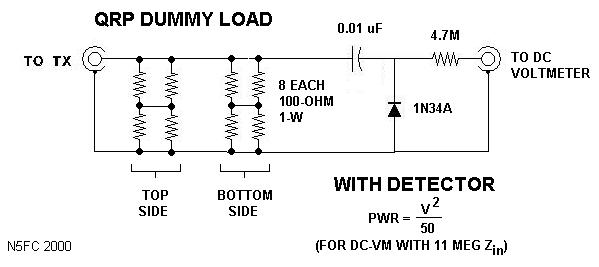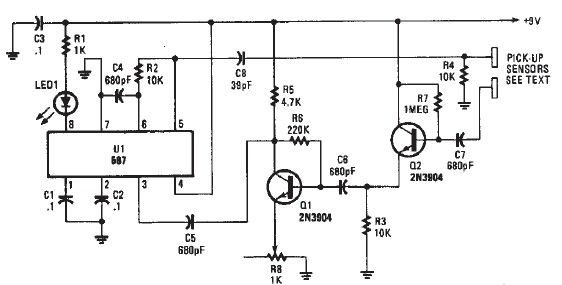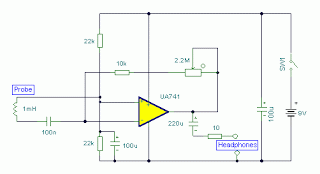
N5ESEs QRP Dummy Load With Built-in RF Detector

This is a variation of the "parallel resistor" dummy load. It is designed for QRP HF operation of 5 watts or less average power and is suitable for continuous operation at that level. The dummy load is compact, measuring approximately 5 inches in length, and features a built-in RF detector with scaling, which can be used with a DC voltmeter to measure power. Dummy loads dissipate energy by generating heat, which can lead to high temperatures that pose a burn risk and could ignite nearby materials. Therefore, it is important to place the dummy load in a safe location. The device is constructed from 1/2-inch copper pipe, which provides an effective form factor and excellent heat dissipation. Copper end caps are used to mount two UG-1094 BNC jacks and close the unit. The design incorporates eight 100-ohm 1-watt 5% metal-oxide resistors, which are readily available. The detector circuit consists of a capacitor, a resistor, and a diode, all of which can also be sourced easily. The resistors are suitable for HF use but are less effective at VHF frequencies. A printed circuit board is fabricated from scrap double-sided copper board, and the resistors are mounted in a specific configuration to achieve the desired resistance. The assembly is then enclosed in copper tubing and connected to the BNC jacks. The final assembly should be checked for proper resistance, and the output wires from the detector are connected to the second BNC jack. A mechanical and electrical connection is established between the end caps for shielding. The dummy load can become warm during operation, and care should be taken to monitor this. The SWR is 1:1 throughout the HF range, and power measurement can be performed using the DC voltage readout.
The described dummy load circuit is an effective solution for low-power HF applications, particularly in experimental or hobbyist settings. The use of copper pipe not only enhances thermal management but also provides a robust physical structure for the assembly. The built-in RF detector is a significant feature, allowing users to measure output power directly and accurately. The choice of resistors is critical; the 100-ohm resistors are selected for their power rating and tolerance, ensuring reliable performance under continuous operation.
The construction involves careful assembly of the printed circuit board (PCB), where the resistors are arranged in parallel and series configurations to achieve the necessary equivalent resistance. The PCB layout is designed to facilitate efficient heat dissipation, and the use of teflon-insulated wire is essential to prevent insulation failure due to heat generated by the resistors.
Safety considerations are paramount; the dummy load should be placed in a non-flammable area, away from materials that could catch fire. Users should also be aware of the heat generated during operation, especially when driving the load with higher power levels. The design's SWR performance indicates that it is suitable for a wide range of HF applications, ensuring minimal signal reflection and efficient power transfer.
In summary, this dummy load circuit is a practical, low-cost solution for amateur radio enthusiasts and provides essential features for power measurement and safe operation. Proper construction techniques and materials selection are crucial to achieving the desired performance and safety standards.This is yet another variation on the "parallel resistor" dummy load. [Go -here- for a discussion on dummy load theory]. This is another one I built during my infatuation with copper pipe. It`s suitable for QRP HF operation of 5-watts or less average power, and should be adequate for continuous operation at that level. It`s light and compact, about 5-inches in length overall. This one is unique in that it has a built-in RF detector, with scaling, that may be used with your DC Voltmeter to measure power. Dummy loads dissipate energy by generating heat. Heat generated in a small space translates to temperature rise, and temperatures can be hot enough (under the right circumstances) to burn people and ignite adjacent materials.
Because of the thermal mass of the dummy load and its enclosure, that heat can stay around for a long time. Always locate your dummy load in a safe place, where there is no chance that it will burn people or catch something on fire.
The 1/2" copper pipe provides a convenient, compact form factor, is an excellent shield, and helps to dissipate heat to the outside world. Copper end-caps, available at most any hardware or plumbing supplier, provide a means of mounting the two UG-1094 BNC jacks and closing the unit.
This version uses 8 each 100-ohm 1-watt 5% metal-oxide resistors, available from Radio Shack for a mere 25-cents each (RS 271-152). All the detector parts (yes, all three of them, a 0. 01 capacitor, a 4. 7-Meg resistor, and a 1N34A diode) are also available at Radio Shack. You would be hard-pressed to spend much more than $5-6 dollars on this project. The resistors are good through the HF range, but don`t do particularly well at VHF. Here`s a schematic: We`ll fabricate a printed-circuit board from scrap double-sided copper board, cut to 1/2 x 2-inches, and grooved to form pads on each side, as shown in the layout below.
On the top side, we`ll mount 4 of the 8 resistors, and on the bottom side we mount the remainder. Simply tack-solder the resistors to the board. Where required to connect the resistors, we drill a small hole through the board, and solder a wire in place top-to-bottom. On the top side, we end up with a 100-ohm, 4-watt equivalent resistor (a pair of parallel 100 ohm resistors makes 50 ohms, and two pairs in series make 100-ohms).
When we join the top and bottom in parallel, our equivalent resistance is 50-ohms (two 100-ohm quads in parallel). Mount a UG-1094 BNC Jack in each of the two copper end-caps. then, connect the pc board assembly directly to the center post of the BNC connector, soldering same.
Make all other interconnections with teflon-insulated wire. DON`T SUBSTITUTE OTHER INSULATIONS! Sorry, I know teflon wire is tough to find, but other insulation types will almost certainly fail when the resistors get hot. Wrap the entire pc-board assembly in teflon tape (often called plumber`s tape, available at any hardware store.
DO NOT use other types of tape (they will melt!). Next, we slide a short piece of 1/2-inch copper tubing over the assembly, slipping it into the BNC/end-cap. At this point, an ohmmeter should verify 50-ohms. Finally, solder the detector output wires to the second BNC, and mount the other end-cap to close and shield the unit.
Drill and tap a screw into both end caps to connect the shield both electrically and mechanically. When supplied RF power for an extended time, this dummy load can get quite warm, even with just 5 watts. Be aware, and plan for it. (Read the "WARNING!" above). My version has an SWR of 1:1 throughout the HF range (DC to 30 MHz). Measuring power is easy, and accurate if the detector`s resistor is sized to work with your DC Voltmeter`s input impedance.
Read the DC Voltage, square it, and divide by 50. Example: we read 10 Volts, which is 10 * 10 / 50 = 2 watts. 🔗 External reference
The described dummy load circuit is an effective solution for low-power HF applications, particularly in experimental or hobbyist settings. The use of copper pipe not only enhances thermal management but also provides a robust physical structure for the assembly. The built-in RF detector is a significant feature, allowing users to measure output power directly and accurately. The choice of resistors is critical; the 100-ohm resistors are selected for their power rating and tolerance, ensuring reliable performance under continuous operation.
The construction involves careful assembly of the printed circuit board (PCB), where the resistors are arranged in parallel and series configurations to achieve the necessary equivalent resistance. The PCB layout is designed to facilitate efficient heat dissipation, and the use of teflon-insulated wire is essential to prevent insulation failure due to heat generated by the resistors.
Safety considerations are paramount; the dummy load should be placed in a non-flammable area, away from materials that could catch fire. Users should also be aware of the heat generated during operation, especially when driving the load with higher power levels. The design's SWR performance indicates that it is suitable for a wide range of HF applications, ensuring minimal signal reflection and efficient power transfer.
In summary, this dummy load circuit is a practical, low-cost solution for amateur radio enthusiasts and provides essential features for power measurement and safe operation. Proper construction techniques and materials selection are crucial to achieving the desired performance and safety standards.This is yet another variation on the "parallel resistor" dummy load. [Go -here- for a discussion on dummy load theory]. This is another one I built during my infatuation with copper pipe. It`s suitable for QRP HF operation of 5-watts or less average power, and should be adequate for continuous operation at that level. It`s light and compact, about 5-inches in length overall. This one is unique in that it has a built-in RF detector, with scaling, that may be used with your DC Voltmeter to measure power. Dummy loads dissipate energy by generating heat. Heat generated in a small space translates to temperature rise, and temperatures can be hot enough (under the right circumstances) to burn people and ignite adjacent materials.
Because of the thermal mass of the dummy load and its enclosure, that heat can stay around for a long time. Always locate your dummy load in a safe place, where there is no chance that it will burn people or catch something on fire.
The 1/2" copper pipe provides a convenient, compact form factor, is an excellent shield, and helps to dissipate heat to the outside world. Copper end-caps, available at most any hardware or plumbing supplier, provide a means of mounting the two UG-1094 BNC jacks and closing the unit.
This version uses 8 each 100-ohm 1-watt 5% metal-oxide resistors, available from Radio Shack for a mere 25-cents each (RS 271-152). All the detector parts (yes, all three of them, a 0. 01 capacitor, a 4. 7-Meg resistor, and a 1N34A diode) are also available at Radio Shack. You would be hard-pressed to spend much more than $5-6 dollars on this project. The resistors are good through the HF range, but don`t do particularly well at VHF. Here`s a schematic: We`ll fabricate a printed-circuit board from scrap double-sided copper board, cut to 1/2 x 2-inches, and grooved to form pads on each side, as shown in the layout below.
On the top side, we`ll mount 4 of the 8 resistors, and on the bottom side we mount the remainder. Simply tack-solder the resistors to the board. Where required to connect the resistors, we drill a small hole through the board, and solder a wire in place top-to-bottom. On the top side, we end up with a 100-ohm, 4-watt equivalent resistor (a pair of parallel 100 ohm resistors makes 50 ohms, and two pairs in series make 100-ohms).
When we join the top and bottom in parallel, our equivalent resistance is 50-ohms (two 100-ohm quads in parallel). Mount a UG-1094 BNC Jack in each of the two copper end-caps. then, connect the pc board assembly directly to the center post of the BNC connector, soldering same.
Make all other interconnections with teflon-insulated wire. DON`T SUBSTITUTE OTHER INSULATIONS! Sorry, I know teflon wire is tough to find, but other insulation types will almost certainly fail when the resistors get hot. Wrap the entire pc-board assembly in teflon tape (often called plumber`s tape, available at any hardware store.
DO NOT use other types of tape (they will melt!). Next, we slide a short piece of 1/2-inch copper tubing over the assembly, slipping it into the BNC/end-cap. At this point, an ohmmeter should verify 50-ohms. Finally, solder the detector output wires to the second BNC, and mount the other end-cap to close and shield the unit.
Drill and tap a screw into both end caps to connect the shield both electrically and mechanically. When supplied RF power for an extended time, this dummy load can get quite warm, even with just 5 watts. Be aware, and plan for it. (Read the "WARNING!" above). My version has an SWR of 1:1 throughout the HF range (DC to 30 MHz). Measuring power is easy, and accurate if the detector`s resistor is sized to work with your DC Voltmeter`s input impedance.
Read the DC Voltage, square it, and divide by 50. Example: we read 10 Volts, which is 10 * 10 / 50 = 2 watts. 🔗 External reference





